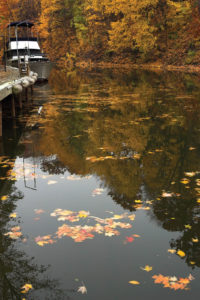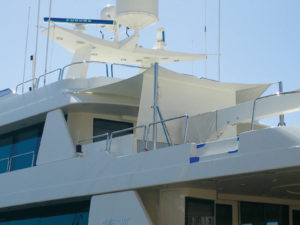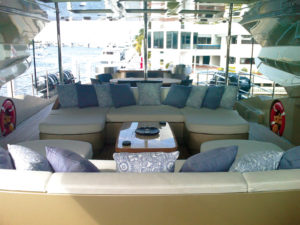Up your profits during your downtime
 The offseason is a good time to catch up with any marine fabrication projects unapproachable during the hectic boating season. But, as companies scramble to remain competitive, the current changing business climate may alter the way craftsmen find clients, no matter what the season. Fabricators from around the country talk about how they’re handling those not-so-busy months—if there is such a thing.
The offseason is a good time to catch up with any marine fabrication projects unapproachable during the hectic boating season. But, as companies scramble to remain competitive, the current changing business climate may alter the way craftsmen find clients, no matter what the season. Fabricators from around the country talk about how they’re handling those not-so-busy months—if there is such a thing.
A traditional offseason
Al Sceiford of Al’s Auto Trim and Upholstery in Erie, Pa., still largely runs his operations on a seasonal basis, mainly due to the climate he lives in. Sceiford’s location on the fourth-largest Great Lake means the winters average 60 inches of snowfall in January alone, with the other winter months not far behind.
“The way I operate is to defer any extra work until the offseason because I am completely overwhelmed with work during the months that boats are on the lake,” Sceiford says. “I just ask people if they can wait until September or October. It’s worked so far, and I’ve been in this business for more than 30 years.”

John Adinolfe of AA Boat Tops & Canvas fabricated a sunshade for the mega yacht Westport. Offseason work typically comes to him through word-of-mouth, and much of that business now involves mega yachts from other regions of the country.
Sceiford does auto upholstery work and commercial work during the winter, including working with a local plastics plant that needs components for some of its machines. His strategy is to get customers to let him work on their boat upholstery during the area’s long offseason. His only employee is one part-time seamstress, and some retired friends who help him with installations when he needs it.
Business has shifted for Sceiford over the years. The early years held close to 60 percent automotive upholstery work, and the remainder was boat fabrication work. Now those numbers are reversed, perhaps due to the better construction of auto seats. “Cars are better built,” Sceiford says. “But boats still have seats that sit out in the sun all day, needing work done on them eventually. My secret is to always have jobs to do in the spring or offseason.”
More work and diversification
Sarris Interiors & amp; Custom Canvas in Long Beach, Calif., primarily does marine work. Owner Nick Sarris’ other division, Anchor Canvas, fabricates commercial and residential awnings. The awning sector of his work came about because many of the boat owners Sarris worked with also had homes, offices and businesses. He found himself subcontracting awnings before deciding to do all that work in-house.
Sarris first started marine canvas work in the late 1980s with one other person. They started out in canvas, and moved on to cushions, segueing into carpet, headliners, hull-liners and even wallpapering. All this diversity smoothed out the winter lull in business, according to Sarris. From there, he expanded into commercial work.
Catalina Express is one of Sarris’ biggest accounts. A ferryboat service, Catalina Express runs its boats from several different harbors in southern California over to Catalina Island and back. The vessels hold from 150 passengers to 350 passengers per boat.

Upholstery and interior work is also a good way to stay busy during offseason. AA Boat Tops & Canvas does a great deal of custom upholstery work. Owner John Adinolfe actually does more upholstery work on exterior mega yacht seating than canvas work lately.
“We do all of the work for them, and primarily their season is summertime,” says Sarris. “Their offseason, when they do the most of the big boat maintenance, is typically from the end of November to sometime in April—some of my busiest times. This is when we do carpeting, all of the upholstery, or canvas covers.”
Catalina Express now has nine boats, which means Sarris has less work time per boat, cutting into any offseason time for him. Sarris also does work for tugboats and cruise ships, as Los Angeles Harbor, Long Beach Port and San Pedro Harbor all have cruise ship terminals.
Because Sarris Interiors has had a sewing business since 1974, it’s well-equipped for when Catalina Express gives the company 300 seat covers to complete in three weeks. Sarris can prototype projects in the marine department and send them to other departments to be bulk-cut and production-sewn.
The marine wallpaper work Sarris does led into some onshore work too. He wallpapered 13 vignettes for The Age of Imagination: Japanese Art, 1615-1868, from the Price Collection exhibit at the Los Angeles County Museum of Art (LACMA). Dry land work proves much easier for Sarris after all the logistics work involved with fitting vessels in water. LACMA received Sarris’ name through the marine work his company has done.
“Most of the work came down to diversifying, not just staying in one niche, and being willing to do other things,” Sarris says. “In the early ’90s I made a decision to seek production work wherever I could to supplement the canvas work.”
Business is different since the beginning of 2008, as they didn’t get their normal backlog for the summer. This change may reflect the ripples of the economy. Sarris is uncertain, but thankful for the work that keeps coming in. When he starts slowing down, Sarris goes through his phone book and asks people if they remember him.
“When we’re in the thick of our summer season I don’t take on as much of the out-of-category work,” he says. “But during the offseason, I’ll look at reupholstering someone’s couch or wall upholstery. We’ve done quite a few screening rooms for movie stars. In summer we’re just way too busy to take on such work. I never say no, I just wait for the right opportunity to present itself.”
Out-of-state work
Back in 1977, John Adinolfe started his canvas and upholstery career in Buffalo, N.Y. In 1978, he moved to West Palm Beach, Fla., where he developed and honed his skills. In April 1981, Adinolfe started AA Boat Tops & Canvas Inc. from scratch. He now works on mega yachts with many prestigious clients. “I consider myself extremely fortunate to have the client base that I have, having been in the business for 31 years,” Adinolfe says.

Al Sceiford of Al’s Auto Trim & Upholstery in Erie, Pa., runs his operations on a seasonal basis. He defers extra work until the offseason and asks customers if they can wait until September or October. Sceiford does auto upholstery work and commercial work during the winter.
AA Boat Tops & amp; Canvas does a lot of custom boat cover work and a great deal of custom upholstery work. Adinolfe actually does more upholstery work on exterior mega yacht seating than canvas work lately. “Unfortunately the materials used are selected by decorators and supplied to me, therefore cutting into the profit margin somewhat,” Adinolfe adds.
Adinolfe has found that business has changed over the course of three decades. It used to be that the season started with locals taking their boats out in early February. Adinolfe would be busy with the local boats until July when lobster season started. August, September and October were typically slow months, until snowbirds arrived in November, and stayed until February. From the start, he did not have an offseason. Adinolfe stays fairly steady all year long.
Adinolfe never looks for work. The work comes to him through word-of-mouth. He stays on an even keel simply working on mega yachts, and much of that business now involves mega yachts from other regions of the country.
“Currently, the majority of my business is out-of-state,” Adinolfe says. “With the recent economic slowdown, the small boater simply cannot afford to take his boat out on the water right now. There is little the small boater is willing to spend. So, instead of spending money on a canvas product, he’s going to put that money into his fuel tank.”
Pat Fleischman of Bear Creek Canvas in Spencer, Wis., points out that a marine fabricator’s best bet may come down to simply getting customers to come to you when you most want them to come. It is possible to manage that time and make it work for you. Fleischman adds that his company’s $25 offseason incentive, though it may not sound like much, does have many people going for it and has been a clear way to buck the industry’s trend of being either feast or famine. It’s a reminder and an incentive at the same time.
“By streamlining things and working some of the feast into the famine it can make life much easier for a marine fabricator,” Fleischman says. “You’re not working under the constant pressure of having too much work or not enough.”
 TEXTILES.ORG
TEXTILES.ORG 






